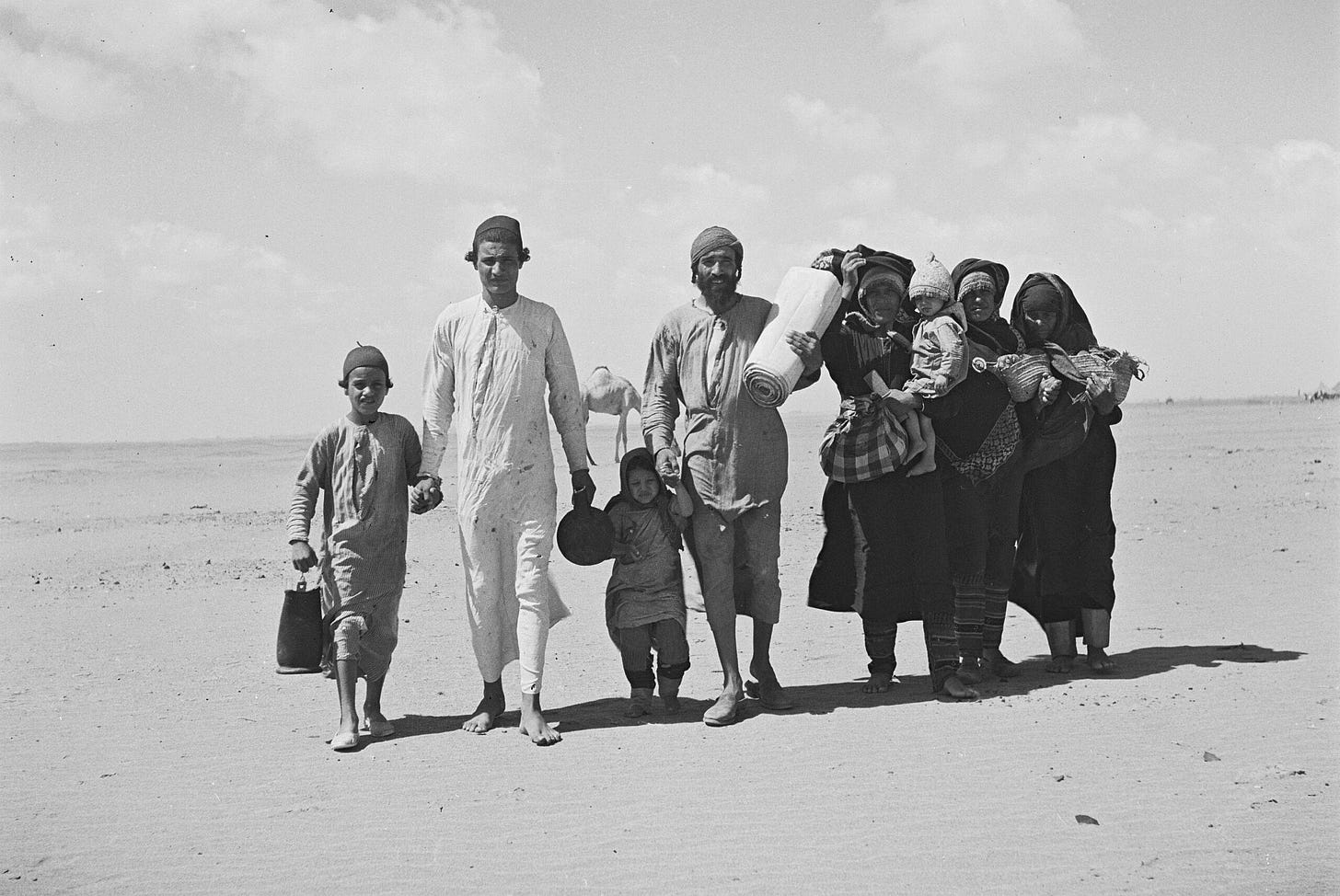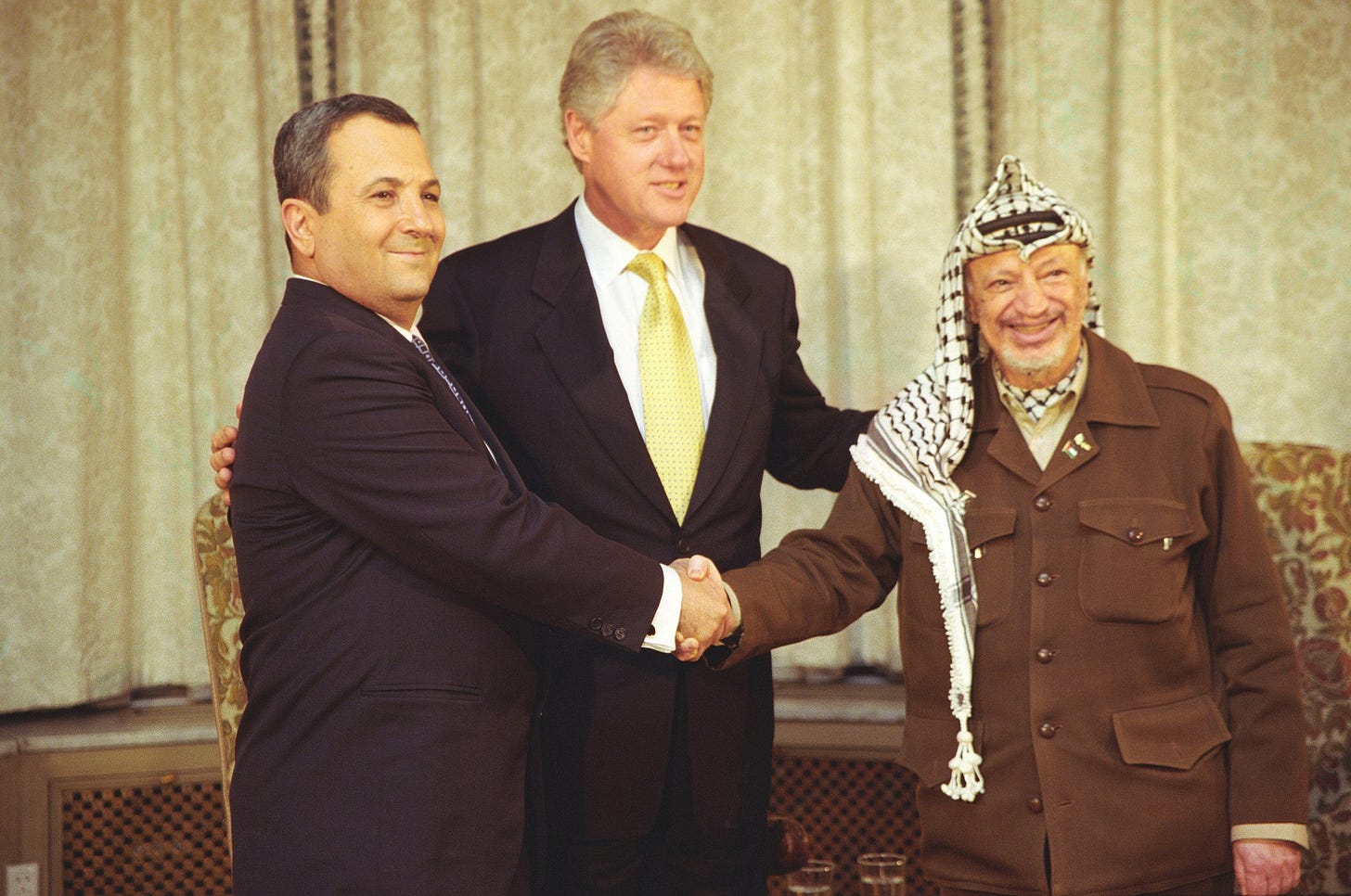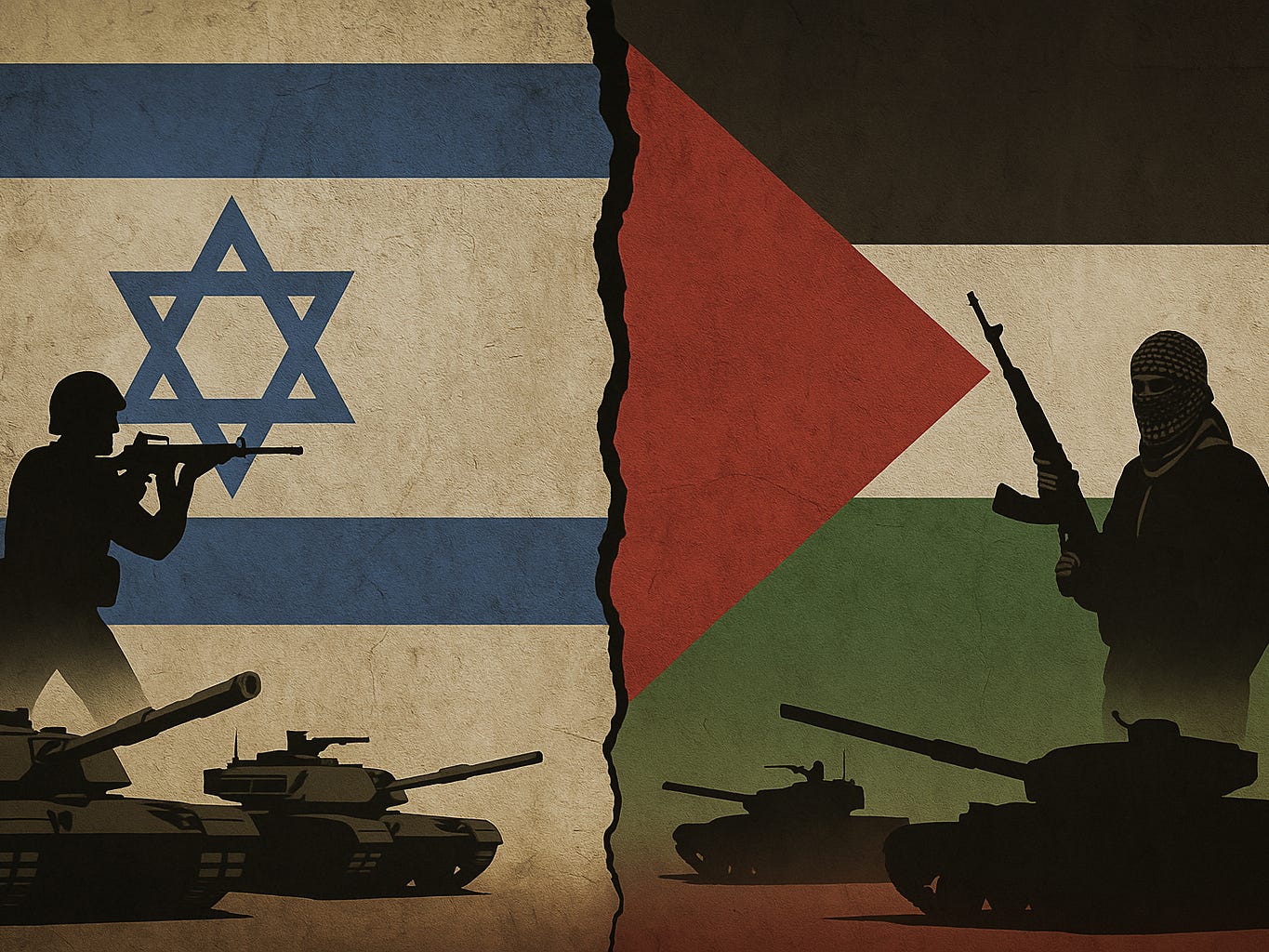Everything you’ve been told about Israel and Palestine is backwards.
The only real way to understand this saga is to understand its perpetual cause-and-effect nature.
Please consider supporting our mission to help everyone better understand and become smarter about the Jewish world. A gift of any amount helps keep our platform free of advertising and accessible to all.
You can also listen to the podcast version of this essay on Apple Podcasts, YouTube Music, YouTube, and Spotify.
The biggest mistake people make when contemplating the Israeli-Palestinian conflict is this: They fail to understand its cause-and-effect nature.
This saga didn’t erupt in a vacuum. It didn’t begin in 1948, or in 1967, or even in the 20th century. It is the latest chapter in a much older story: the long and complicated Jewish-Arab conflict, which was later rebranded as the Israeli-Arab conflict and, eventually, the Israeli-Palestinian conflict.
For centuries, Jews living in Arab lands were treated as dhimmis under Islamic rule. A dhimmi was a non-Muslim, usually Jew or Christian, who was allowed to live under Muslim governance but only as a second-class citizen. Dhimmis had to pay a special tax called the jizya, adhere to restrictive laws, and accept systemic discrimination. They were tolerated, not respected.
History is full of violent outbursts against Jewish communities in Arab lands: pogroms, expulsions, and massacres. One infamous example is the Battle of Khaybar in the 7th century, when Muhammad’s forces defeated the Jewish tribes of Khaybar, leading to mass killings and the subjugation of Jews. The Arabic chant “Khaybar, Khaybar, ya Yahud” (Khaybar, Khaybar, oh Jews) is still invoked by Islamist extremists today as a genocidal rallying cry.
The Jewish story in Arab lands (and, really, across the world) begins with another cause and effect that most people ignore. Two thousand years ago, Jews were expelled from Judea after revolts against the Roman Empire. That’s why we’re called Jews — from Judea, the land of our origin. After the destruction of the Second Temple in 70 CE and the Bar Kokhba revolt in 135 CE, Jews were scattered across the Middle East, North Africa, and Europe.
This dispersion was not voluntary; it was the direct result of conquest and expulsion. Jews didn’t leave their homeland because they wanted to; they were forced out at sword point, enslaved, massacred, and scattered. And everywhere they went, they carried their identity, their faith, and their yearning for Judea, our homeland. For centuries, Jewish prayers ended with the words: “Next year in Jerusalem.” That’s not poetry; it’s history’s longest-running declaration of indigenous belonging.
Now, let’s do the basic math:
Jews are exiled from Judea.
Jews become minorities in Arab lands.
Jews live as dhimmis under Islamic rule.
Persecution, pogroms, and forced conversions become a recurring reality.
And, thus, in the late 19th and early 20th centuries, Zionism emerges not as a colonial project, but as the most natural reaction to 2,000 years of exile and oppression: reclaiming the ancestral homeland from which they were expelled.
Early Zionists didn’t arrive with guns and tanks; they arrived with plows and deeds. During Ottoman-era Palestine, Jews bought land legally from Ottoman officials and local Arab landowners. These were documented sales, often at exorbitant prices, and much of the land purchased was swamp, desert, or otherwise uncultivable.
The Zionists transformed it. They drained malarial swamps, planted forests, and developed infrastructure. What had been a sparsely populated backwater of the Ottoman Empire became an increasingly liveable land.

This sparked the first cause-and-effect dynamic: Jews began building a modern economy, and Arabs from across the Middle East and North Africa migrated there for better-paying jobs. The myth that Palestinians as a people have been on the land “for thousands of years” is exactly that — a myth. Some families have deep roots; many others arrived during the 19th and early 20th centuries from Syria, Egypt, and other parts of the Arab world, drawn by Jewish-created opportunities.
As Jewish immigration grew, tensions rose. Arabs feared losing their majority; Jews feared returning to dhimmi status — or worse. In 1937, the British Peel Commission proposed partition: a two-state solution decades before the United Nations ever did. Jews accepted it reluctantly; Arabs rejected it outright.
This is another crucial cause and effect: Arab refusal to accept any Jewish sovereignty hardened Jewish resolve to prepare for war, not because Jews wanted war, but because the alternative was annihilation.
When Jews eventually declared independence in 1948, Arab states attacked within hours. Arab leaders even told local Arabs to flee, promising they could return after a swift victory over the Jews. That victory never came.
The Jews survived and emerged victorious. Many Arabs who fled became permanent refugees — not because Jews expelled them en masse (though expulsions did occur amid fighting), but because their leaders bet on genocide and lost.
Arabs who stayed became Israeli citizens. Today, their descendants enjoy more rights and freedoms in Israel than Arabs do in any other Middle Eastern and North African country. That’s not propaganda; that’s reality.
After 1948, Israel leaned West. Initially, the Soviets flirted with supporting Israel, but antisemitism under Stalin and Israel’s Western orientation pushed Moscow to change course. The USSR began backing Arab regimes and, in the 1960s, discovered a powerful proxy: the Palestinian cause.
Here comes another major cause and effect: The Soviets helped rebrand the Palestinian struggle. Before then-Palestinian leader (and mega-terrorist) Yasser Arafat’s Soviet grooming, his rhetoric was blunt: “We will exterminate the Jews who stole our land.” The Soviets advised him to stop talking about extermination and start talking about “liberation” and “anti-colonial struggle.” This language resonated in a post-colonial world and played perfectly into Western guilt over the Holocaust and imperialism.
Thus began the propaganda campaign that casts Palestinians as eternal victims and Jews as “white European colonizers” — a historically absurd but brilliantly effective inversion of reality.
Among the Arafat-led Palestine Liberation Organization’s first order of operations was terrorism against Israel — supported by the Soviets, their most enduring success against the “free world” according to Major General Ion Mihai Pacepa, the highest-ranking Soviet bloc defector during the Cold War.
Pacepa wrote that, for nearly four decades, the Palestine Liberation Organization was the largest, wealthiest, and most politically connected terrorist organization in the world. It used drug trafficking, arms smuggling, money laundering, and counterfeiting to amass a fortune estimated to be $10 billion by the early 1990s (nearly $25 billion if adjusted for inflation today). The Palestine Liberation Organization collaborated with international criminal organizations, drug cartels, other terror groups, and rogue states such as Libya, Iran, Iraq, North Korea, and Sudan.
Arafat, who became chairman of the Palestine Liberation Organization in 1969, was notoriously corrupt, using public funds for his own purposes, which ranged from financing an expensive lifestyle in Paris for his wife, to buying and retaining the support of Palestinian politicians.
For decades, Palestinians were taught victimhood as an identity and violence as a strategy. That boiled over in the First Intifada (1987–1993) and exploded in the Second Intifada (2000–2005), when Palestinian terrorists blew up buses, cafes, and shopping centers across Israel, in addition to stabbings, shootings, and other forms of terror.

Until then, movement between Israel and Palestinian areas was relatively open. That ended when Israelis started burying their own civilians murdered in cold blood by Palestinian terrorists.
Another clear cause and effect: Palestinians used open borders to murder civilians; Israel built a security barrier to stop them. And it worked. Suicide bombings dropped dramatically. To claim the wall was arbitrary is like claiming seatbelts have nothing to do with car crashes.
Between the intifadas, Israel and the Palestinians signed the Oslo Accords in the 1993 and 1995, creating the Palestinian Authority and raising hopes for peace. But the deal left core issues unresolved: Jerusalem, refugees, borders. Arafat, who had spent decades selling martyrdom and “resistance” to his people, could not pivot to selling compromise.
So, when then-U.S. President Bill Clinton offered an unprecedented peace package in 2000, Arafat walked away and unleashed the Second Intifada instead. Once again: When offered peace, Palestinian leadership chose barbaric war.
And here’s another profound cause and effect most people overlook: The Second Intifada killed the two-state solution in the minds of many Israelis. Before 2000, a majority of Israelis supported the idea of two states, even after decades of violence. They believed, often reluctantly, that territorial compromise could bring peace. Oslo was built on that hope. But after thousands of terror attacks, hundreds of suicide bombings, and thousands of Israeli civilians murdered, that hope shattered.
Israelis looked at the facts: We offered land, we offered statehood, and we got exploding buses and blown-up children in return. The lesson was brutal but clear: For too many Palestinians, “peace” was a pause between wars, not an end to conflict. This wasn’t about settlements or borders; it was about survival.
So Israelis shifted. Support for sweeping concessions plummeted. Skepticism toward Palestinian leadership cemented. And who could blame them? When your neighbor answers your olive branch with a bomb belt, you stop planting olive trees.

Then, in 2005, Israel made a surprise move by unilaterally withdrawing from Gaza, including dismantling Jewish neighborhoods there and removing every last Israeli civilian and soldier. The world applauded. Palestinians could have turned Gaza into a halfway-decent destination.
Instead, Hamas violently seized control and ousted the Palestinian Authority from the Strip, turned Gaza into a terror base, and indiscriminately launched thousands of rockets at Israeli civilians. Israel responded with blockades and military operations, not because it wanted to “occupy” Gaza — it had left Gaza — but because Hamas turned Gaza into a launchpad for perpetual war. That’s what jihadists want: perpetual war.
Here’s the chain of cause and effect:
Israel leaves Gaza. → Hamas takes over.
Hamas takes over. → Hamas turns Gaza into a terror fortress.
Hamas builds terror infrastructure. → Hamas attacks Israel repeatedly.
Israel builds a blockade and defense systems → Hamas cries “siege” to gain global sympathy.
Then came mini-wars between Israel and Hamas in 2014, 2021, and countless rocket escalations in between. Every few years, Hamas provoked a war, drawing Israel into another round of fighting, while perfecting a cynical strategy: Embed its weapons and infrastructure under schools, mosques, and hospitals so civilian casualties could be weaponized for global PR. And the world fell for it every single time.
Fast-forward to October 7, 2023 — the bloodiest day for Jews since the Holocaust. This massacre didn’t come out of nowhere. It was the logical, horrific consequence of decades of cause and effect.
Now, as much of Gaza lies in ruins, we can shed crocodile tears, or we can look at it for what it is: cause and effect. Hamas launched a war it could never win, even with Hezbollah and the Houthis expanding the front against Israel. It gambled with the lives of its own people, betting that dead civilians would be its greatest weapon. That’s not strategy; that’s savagery.
And yet, predictably, much of the world rewards this behavior with sympathy, headlines, and political pressure on Israel to stop defending itself.
But here’s the undeniable truth: If Hamas had not massacred 1,200 people on October 7th, Gaza would not be in ruins. If Hamas had invested in schools instead of tunnels, if it had chosen coexistence over jihad, Gaza could have been a booming coastal economy instead of a graveyard.
Every bomb that falls on Gaza is the direct consequence of Hamas’ decision to make war on Israel and embed its terror machine among civilians. That is the ultimate cause and effect — and suggesting otherwise is a moral, intellectual, and psychological misrepresentation.
As you can see, the tragedy of the Jewish-Arab conflict is not rooted in land, settlements, or even borders. It is rooted in a relentless refusal, by much of the world, to see the cause-and-effect reality.
Instead of demanding accountability from Palestinian leadership and society, the international community has spent decades enabling a culture of victimhood, rejectionism, and terror.
Every time the world excuses Palestinian violence as “resistance,” every time it rewards intransigence with more “humanitarian aid” (which knowingly gets syphoned by Palestinian terrorists), it reinforces the same destructive cycle: Violence brings attention, attention brings concessions, and concessions bring no peace — only more violence.
Cause and effect. Simple. Rational.



This is a powerfully accurate and truthful review of Israeli-Arab history. This should be required reading for anyone who is interested or curious about the Middle East. Perhaps it would be helpful if Steve Witkoff read this article.
Concise and powerful! Should be distributed to high school and college students, whose attention spans have diminished and need "short and sweet" things to read.